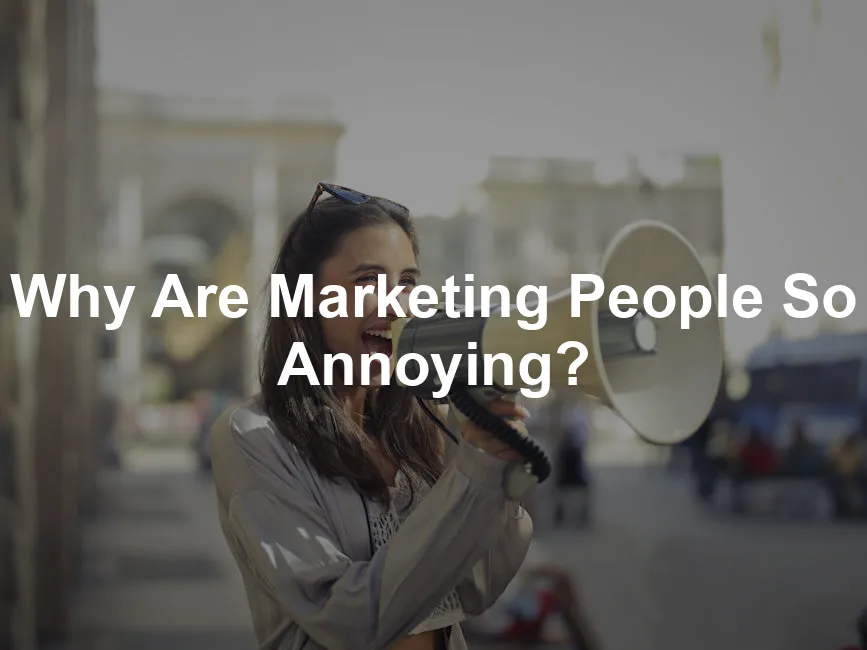
Why Are Marketing People So Annoying?
Introduction
In a world where every click counts and every impression matters, marketing has become both an art and a necessary evil. But let’s be honest—marketing professionals often get a bad rap. Whether it’s the incessant emails, aggressive social media tactics, or over-the-top promotional campaigns, many people find themselves rolling their eyes at the mere thought of marketers. But why is that?
Is it their relentless pursuit of sales? Their knack for making everything sound like a limited-time offer? Or perhaps it’s just that they’ve taken the idea of “selling” a bit too far?
The truth is, marketing annoyance comes from a combination of factors. First, there’s that ever-present feeling of being pushed. You know, the “buy now or miss out” urgency that sends chills down your spine? Then, there’s the flood of messages bombarding your inbox—it’s like playing dodgeball but with marketing emails instead of balls.
In the digital age, ads seem to creep into every corner of our lives. From social media feeds to random pop-ups while browsing, it’s hard to escape the marketing machinery. This constant exposure can feel like a never-ending assault, leading to frustration and eye rolls.
Moreover, many marketing tactics can come off as insincere or manipulative. If we’re honest, nobody likes to feel like a target for someone else’s agenda. While marketers may want to help consumers, the delivery often feels more like a sales pitch than genuine support.
As we dive deeper into this topic, let’s take a closer look at the reasons behind the annoyance, explore common grievances, and maybe, just maybe, find a way to bridge the gap between marketers and their critics.

Summary of Key Points
- Understanding Marketing Annoyance: This section addresses common perceptions that marketers are pushy, manipulative, and inauthentic.
- The Role of Digital Marketing: How the digital age has amplified these annoyances through relentless ads, spam emails, and aggressive social media strategies.
- Real-Life Examples: Anecdotes and case studies showcasing the most annoying marketing tactics that people encounter daily.
- Psychology Behind the Annoyance: Insights into why certain marketing strategies lead to frustration, backed by psychological theories and consumer behavior studies.
- The Path Forward: Suggestions for marketers on how to improve their tactics and foster better relationships with consumers.
The Anatomy of Annoying Marketing
What Makes Marketing Annoying?
Pushy Tactics
Imagine being followed around a store by a salesperson who insists you buy the latest gadget. Annoying, right? That’s how many feel about pushy marketing tactics. When marketers bombard consumers with aggressive sales pitches, it creates immediate resentment. Instead of enticing customers, these tactics often drive them straight to the nearest exit.
A survey found that 70% of consumers dislike high-pressure sales tactics. When your inbox is flooded with “limited-time offers” and “only a few left” messages, it feels less like marketing and more like a digital hostage situation. Customers want to feel valued, not pressured. Brands should focus on building relationships rather than wielding a hard sell.

If you’re looking to dive deeper into effective marketing strategies, consider picking up Marketing for Dummies. This book provides a solid foundation for understanding the principles of marketing and how to apply them without being annoying!
Spam and Overcommunication
Raise your hand if you’ve ever felt overwhelmed by endless promotional emails. With marketers sending an average of 121 emails per person every day, it’s no wonder consumers are tuning out. Spam and overcommunication dilute the effectiveness of genuine marketing efforts, leaving consumers annoyed and disengaged.
Social media is another culprit. With ads popping up in every scroll, users often feel like they’re swimming in a sea of marketing noise. The key is to respect consumer time. A thoughtful, less frequent approach can resonate more than incessant promotions. Quality over quantity should be the mantra.

For those wanting to explore the psychology behind effective marketing, “The Psychology of Selling” is a great read that provides insights into consumer behavior and effective sales techniques.
Manipulation and Deception
We’ve all seen those ads that promise the impossible: “Lose 20 pounds in a week!” or “Become a millionaire overnight!” Such misleading claims erode trust. When consumers discover they’ve been duped, they don’t just roll their eyes—they roll away from that brand.
Authenticity in marketing is crucial. Brands that are transparent about their offerings and avoid deceptive tactics foster loyalty. When consumers feel respected and informed, they’re more likely to engage positively with a brand.

The Evolution of Marketing
From Traditional to Digital
Marketing has undergone a seismic shift. Gone are the days when marketers relied solely on billboards and TV commercials. The digital age brought with it a multitude of platforms, which opened new avenues for engagement—but also new pitfalls.
Brands now face a double-edged sword. While digital marketing offers vast reach, it also means consumers are inundated with messages. The challenge is to stand out without becoming a nuisance. Understanding this balance is key to avoiding the annoying pitfalls of modern marketing.

If you’re interested in how to craft a compelling narrative in your marketing, check out “Building a StoryBrand”. This book teaches you how to clarify your message so customers will actually listen!
The Rise of Content Marketing
Content marketing was hailed as the savior of the industry. Instead of pushing products, brands aimed to provide value through engaging content. However, this approach has its drawbacks. Clickbait headlines and intrusive ads have become common, leading many to view content marketing skeptically.
Consumers grow weary of the “fake news” feel of clickbait. They want genuine information that enhances their lives—not clever tricks to get them to click. Brands must prioritize authenticity and relevance in their content to avoid annoying their audience.

Real-Life Examples of Annoying Marketing
Case Studies
Consider the infamous “Are you still there?” pop-up ads that plague online shopping experiences. These intrusive messages disrupt the user experience and often lead to frustration rather than conversion.
Another classic example is the “We’ve missed you!” email sent a week after a customer’s last purchase. If you’ve just bought something, the last thing you want to see is an email suggesting you might have forgotten about the brand.

Consumer Testimonials
“I can’t stand when brands act like my best friend, then try to sell me something every five minutes,” says Sarah, a frustrated consumer. “It feels dishonest. Just be real with me!”
Another consumer, Tom, echoes this sentiment: “I get so many spammy emails that I’ve started deleting anything that looks promotional. It’s just too much.”
By addressing these annoyances, marketers can create a more positive relationship with their audience. Respect and authenticity are the foundations for effective marketing that doesn’t irritate consumers.

The Psychology of Annoyance
Consumer Behavior Insights
Cognitive Overload
In today’s fast-paced world, information is everywhere. Marketers bombard consumers with endless messages, offers, and ads. This constant influx can lead to cognitive overload. When faced with too much information, our brains struggle to process it all. The result? Frustration and annoyance.
Imagine trying to choose a new cereal. You walk down the aisle and see 50 different options. Each box promises to be the best. Confused? You’re not alone! Research shows that people often make poor choices when overwhelmed. When marketers pile on the information, consumers may tune out. They feel like they’re drowning in decisions. This cognitive overload is a surefire way to annoy potential customers.

Emotional Responses
Marketers often tap into emotions to drive purchases. But this emotional manipulation can backfire. Many consumers resent feeling played. They don’t appreciate brands that tug at their heartstrings only to sell them something.
Think about those advertisements that pull on your heart. They might highlight a touching story or a family reunion. But when you realize the goal is to sell you a product, it can feel disingenuous. This emotional bait-and-switch can lead to backlash. Instead of building connections, marketers may find themselves facing a wave of resentment.

The Trust Factor
Building vs. Eroding Trust
Trust is a cornerstone of consumer relationships. Marketers have a unique position to build or erode that trust. When brands use manipulative tactics, they risk losing credibility.
Consider the brand that promises “the best deal ever” but hides extra fees in the fine print. Consumers feel deceived, and trust erodes. According to studies, 81% of consumers need to trust a brand before making a purchase. That’s a staggering number! Building trust requires transparency and honesty in messaging. Marketers should focus on creating genuine connections rather than employing questionable tactics.

Authenticity in Marketing
In an age of skepticism, authenticity reigns supreme. Consumers crave realness. They want to connect with brands that reflect their values and beliefs. Marketers who prioritize authenticity can create positive consumer experiences.
Think of brands that share their story, values, and mission. They engage consumers on a deeper level. Authentic marketing fosters loyalty and trust. When consumers feel valued and understood, they’re more likely to return. So, instead of resorting to gimmicks, marketers should strive for authenticity. It’s a powerful tool in creating lasting relationships with audiences.
By understanding the psychological factors at play, marketers can adjust their strategies. The key is to respect consumers’ time and emotions. When they do, they can reduce annoyance and foster positive connections.

Strategies for Marketers to Reduce Annoyance
Adopt a Consumer-Centric Approach
Focus on Value
Shifting from a sales-first mentality to a consumer-first mentality can work wonders. Marketers need to think like consumers. What do they genuinely want? It’s not just about pushing products. Instead, it’s about providing real value.
Imagine walking into a store only to be instantly bombarded with aggressive sales pitches. Not fun, right? Marketers should focus on understanding consumer needs. They can achieve this through research, surveys, or even just chatting with customers. When marketers prioritize delivering value, they build trust. Trust leads to loyalty, and loyalty leads to sales.
So, how can marketers do this? Start by identifying pain points. What problems do consumers face? Address these issues with genuine solutions. Think of it as the ultimate matchmaking service: “Hey, we know you’re struggling with this, and here’s our product to help!” Sounds better than the usual “Buy now!” pitch, doesn’t it?

Speaking of providing value, if you’re interested in personal development, check out “The 7 Habits of Highly Effective People”. This classic book can help you develop effective habits that will lead to success in both marketing and life!
Respecting Time and Space
Time is precious. Consumers don’t want to waste it on intrusive marketing tactics. Marketers should respect this. Think about it: would you want to be interrupted during your favorite show? Absolutely not! Therefore, marketers should avoid intrusive ads that pop up at the worst possible moments.
Instead, create content that fits naturally into consumers’ lives. This means choosing the right platforms and timing for your messages. For instance, social media can be a great avenue, but if your ad pops up while someone’s scrolling through family photos, it’s going to be met with eye rolls.
Mindfulness in marketing means knowing when to approach customers. Use data analytics to understand peak engagement times. When you respect consumers’ time and space, you foster a positive relationship. They’ll appreciate your efforts and be more receptive to your message.

Improve Engagement Tactics
Quality Over Quantity
Let’s face it: nobody enjoys being overwhelmed with ads. A flood of promotions can drown out the genuine messages. Instead of bombarding consumers, marketers should focus on delivering quality content.
High-quality content resonates. It informs, entertains, or solves a problem. Imagine receiving a well-crafted email that actually addresses your needs—it feels refreshing! By focusing on quality over quantity, marketers can capture attention and keep it.
Marketers should strive to create engaging content that sparks interest. This could be through informative blog posts, engaging videos, or eye-catching graphics. When marketers prioritize quality, they invite consumers into a conversation rather than a sales pitch.

If you’re looking for an insightful read on effective marketing strategies, consider “Digital Marketing For Dummies”. This book covers a myriad of contemporary marketing techniques that can help you engage your audience effectively.
Personalization
Now, let’s talk about personalization. Consumers love when brands cater to their preferences. Tailoring marketing messages can significantly enhance consumer experiences. It’s like walking into a coffee shop where the barista knows your order. You feel valued and appreciated, right?
Marketers should leverage data to understand consumer behavior. Use insights from past purchases or browsing history to create personalized recommendations. This approach fosters a sense of connection. Consumers are more likely to engage with brands that understand their needs.
However, personalization should be done thoughtfully. Bombarding consumers with overly targeted ads can feel invasive. Balance is key. Use personalization to enhance the experience, not overwhelm it. When done right, personalized marketing leads to higher engagement and satisfaction.
In conclusion, marketers can reduce annoyance by adopting a consumer-centric approach and improving engagement tactics. By focusing on value, respecting consumers’ time, prioritizing quality, and personalizing experiences, marketers can create meaningful connections. This not only benefits the consumers but also cultivates a positive brand image. So, let’s raise the bar and make marketing a delightful experience for everyone!
Conclusion
Marketing can be vital for business success, but it doesn’t have to annoy us. We’ve uncovered the reasons behind the disconnect between marketers and consumers. Often, it’s due to pushy tactics and a lack of understanding. Marketers can easily slip into aggressive sales tactics that feel more like a digital assault than a friendly nudge. Who wants to feel like a target rather than a valued customer?
Consumers are not just data points. They are real people with emotions and preferences. When marketers forget this, they risk alienating their audience. The key to reducing annoyance lies in adopting a more authentic, consumer-focused approach. Marketers should aim to build genuine relationships with their audience.
Imagine if marketers took a step back. What if they reassessed their strategies and prioritized understanding their customers’ needs? This change could transform the marketing landscape. Instead of bombarding consumers with relentless ads and promotions, they could foster meaningful connections.
Remember, at the heart of every campaign is a real person with real feelings. When marketers embrace this truth, they’ll find more success. It’s time to prioritize value over pressure, authenticity over manipulation. By doing so, marketers can create campaigns that resonate and engage without irritation. Let’s make marketing a delightful experience for both consumers and brands alike.
FAQs
Why do people find marketers annoying?
Many individuals perceive marketers as annoying due to their pushy behaviors. Overly aggressive sales tactics, constant promotional emails, and intrusive ads can lead to frustration. For instance, consumers often receive numerous emails urging them to buy immediately, creating a sense of urgency that feels overwhelming. Additionally, spammy tactics, like unsolicited contact or misleading subject lines, can contribute to negative feelings about marketers.
Is all marketing annoying?
Not all marketing is annoying. Effective marketing strategies can engage consumers without being intrusive. For example, thoughtful content marketing that offers valuable insights can be appreciated. Brands like Patagonia and Dove have successfully created campaigns that resonate deeply without coming off as pushy. Their authentic messaging fosters genuine connections with their audiences.
How can marketers improve their image?
To enhance their image, marketers should focus on being more transparent and respectful. They can adopt permission-based marketing practices, ensuring they only contact interested consumers. Additionally, by creating content that genuinely provides value and engages rather than sells, they can build a more positive reputation. Personalized marketing that respects consumer preferences can also strengthen relationships.
What role does technology play in annoying marketing?
Technology has drastically changed marketing, often contributing to annoyance. Automated emails, social media ads, and retargeting can create feelings of being constantly watched. While these tools can improve targeting, they can also backfire. When consumers receive irrelevant ads or experience excessive retargeting, it can feel invasive and frustrating. Marketers should use technology wisely to enhance the customer experience without overwhelming them.
Can consumers benefit from marketing?
Yes, consumers can benefit from well-executed marketing. Effective marketing can inform consumers about products and services that genuinely meet their needs. For instance, a carefully crafted advertisement that highlights a product’s unique benefits can guide consumers toward making informed choices. Additionally, brands that prioritize consumer feedback and engagement can create products that enhance consumers’ lives. When done right, marketing serves as a valuable resource rather than a nuisance.
Please let us know what you think about our content by leaving a comment down below!
Thank you for reading till here 🙂
Understanding emotional responses is essential for marketers to connect better with consumers. why understanding emotional responses is crucial for mental health
All images from Pexels




